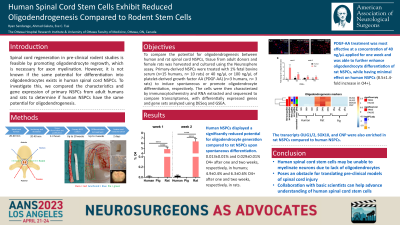Human Spinal Cord Stem Cells Exhibit Reduced potential for Oligodendrogenesis Compared to Rodent Stem Cells
Human Spinal Cord Stem Cells Exhibit Reduced Potential for Oligodendrogenesis Compared to Rodent Stem Cells
Friday, April 21, 2023


Ryan V. Sandarage, MD (he/him/his)
Neurosurgery Resident
The Ottawa Hospital
Ottawa, Ontario, Canada
ePoster Presenter(s)
Introduction: In pre-clinical rodent models, endogenous neural stem/progenitor cells (NSPCs) in the spinal cord represents promising target to stimulate oligodendrocyte regeneration. It is unclear whether human spinal cord NSPCs possess the same potential to differentiate into oligodendrocytes as rat NSPCs. We directly compared the functional and transcriptional profiles of primary spinal cord NSPCs from adult humans and rats to determine if human NSPCs possess the same potential for oligodendrogenesis.
Methods: Spinal cord tissue from adult human organ donors and female rats were harvested and primary NSPCs were cultured using the Neurosphere assay. To induce spontaneous differentiation, primary-derived NSPCs (pdNSPCs) were treated with 1% fetal bovine serum (n=15 humans, n= 10 rats). To promote oligodendrocyte differentiation, pdNSPCs were treated with 40 ng/µL or 100 ng/µL of platelet-derived growth factor AA (PDGF-AA) (n=3 humans, n= 3 rats). pdNSPCs were treated for one or two weeks and characterized by immunocytochemistry. To compare transcriptomes, human (n=6) and rat pdNSPCs (n=3) had their RNA extracted and sequenced using the NextSeq platform. Differentially expressed (DE) genes and gene sets were analyzed using DESeq and GSEA, respectively.
Results: Upon spontaneous differentiation, human NSPCs generated fewer oligodendrocytes (0.013±0.01% and 0.029±0.01% O4+ after one and two weeks, respectively) compared to rat NSPCs (4.9±0.4% and 6.3±0.6% O4+ after one and two weeks, respectively). Oligodendrocyte differentiation of rat NSPCs but not human NSPCs could be further enhanced with PDGF-AA treatment which was most effective at a concentration of 40 ng/µL applied for one week (8.5±1.4 fold increase in O4+). Rat NSPCs were enriched in the transcripts OLIG1/2, SOX10, and CNP.
Conclusion : We have directly compared the potential for oligodendrogenesis between primary human and rat spinal cord NSPCs. Human NSPCs bear little potential for oligodendrogenesis at a functional and transcriptional level which may impact the successful translation of myelinating strategies.
Methods: Spinal cord tissue from adult human organ donors and female rats were harvested and primary NSPCs were cultured using the Neurosphere assay. To induce spontaneous differentiation, primary-derived NSPCs (pdNSPCs) were treated with 1% fetal bovine serum (n=15 humans, n= 10 rats). To promote oligodendrocyte differentiation, pdNSPCs were treated with 40 ng/µL or 100 ng/µL of platelet-derived growth factor AA (PDGF-AA) (n=3 humans, n= 3 rats). pdNSPCs were treated for one or two weeks and characterized by immunocytochemistry. To compare transcriptomes, human (n=6) and rat pdNSPCs (n=3) had their RNA extracted and sequenced using the NextSeq platform. Differentially expressed (DE) genes and gene sets were analyzed using DESeq and GSEA, respectively.
Results: Upon spontaneous differentiation, human NSPCs generated fewer oligodendrocytes (0.013±0.01% and 0.029±0.01% O4+ after one and two weeks, respectively) compared to rat NSPCs (4.9±0.4% and 6.3±0.6% O4+ after one and two weeks, respectively). Oligodendrocyte differentiation of rat NSPCs but not human NSPCs could be further enhanced with PDGF-AA treatment which was most effective at a concentration of 40 ng/µL applied for one week (8.5±1.4 fold increase in O4+). Rat NSPCs were enriched in the transcripts OLIG1/2, SOX10, and CNP.
Conclusion : We have directly compared the potential for oligodendrogenesis between primary human and rat spinal cord NSPCs. Human NSPCs bear little potential for oligodendrogenesis at a functional and transcriptional level which may impact the successful translation of myelinating strategies.
